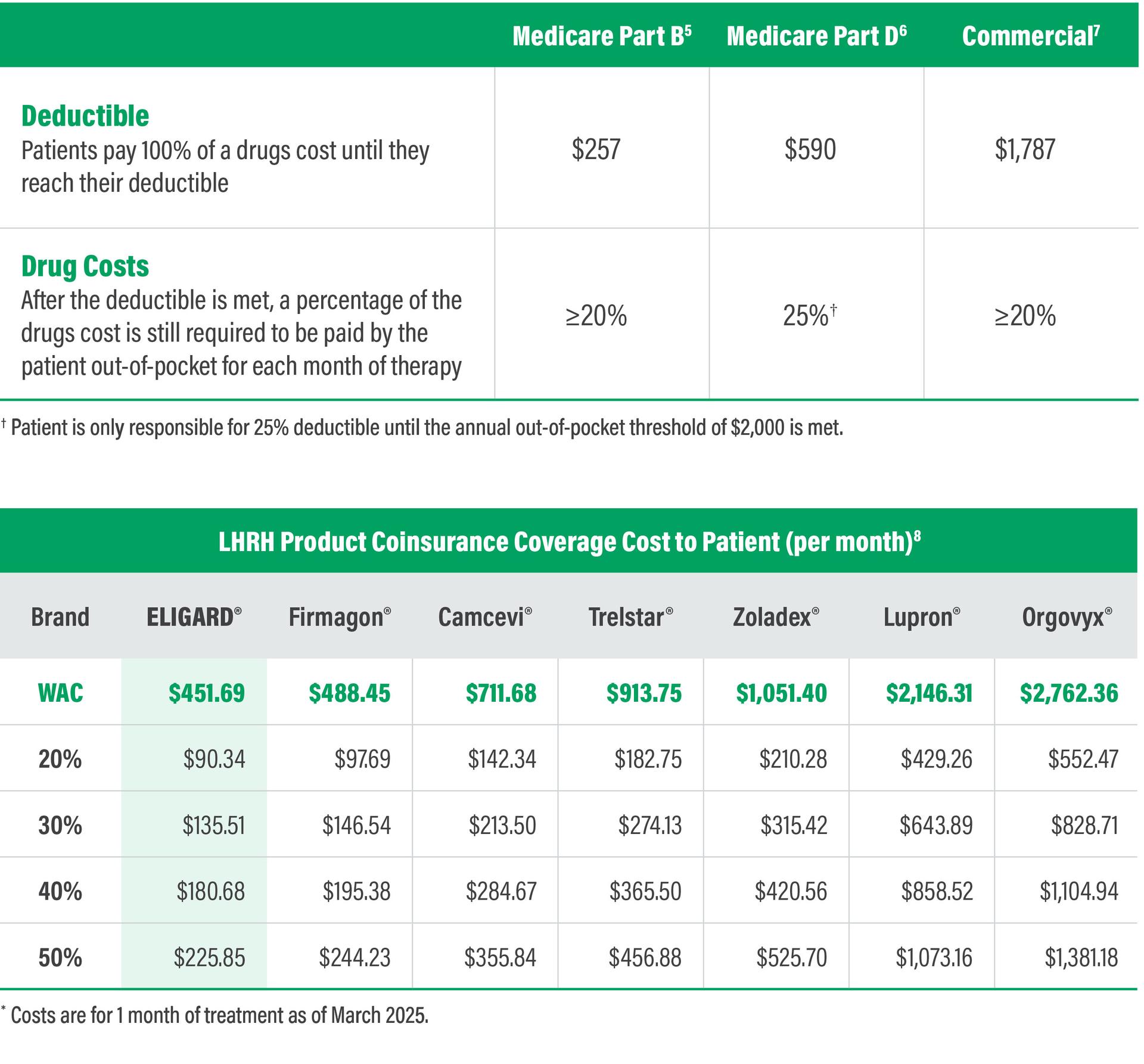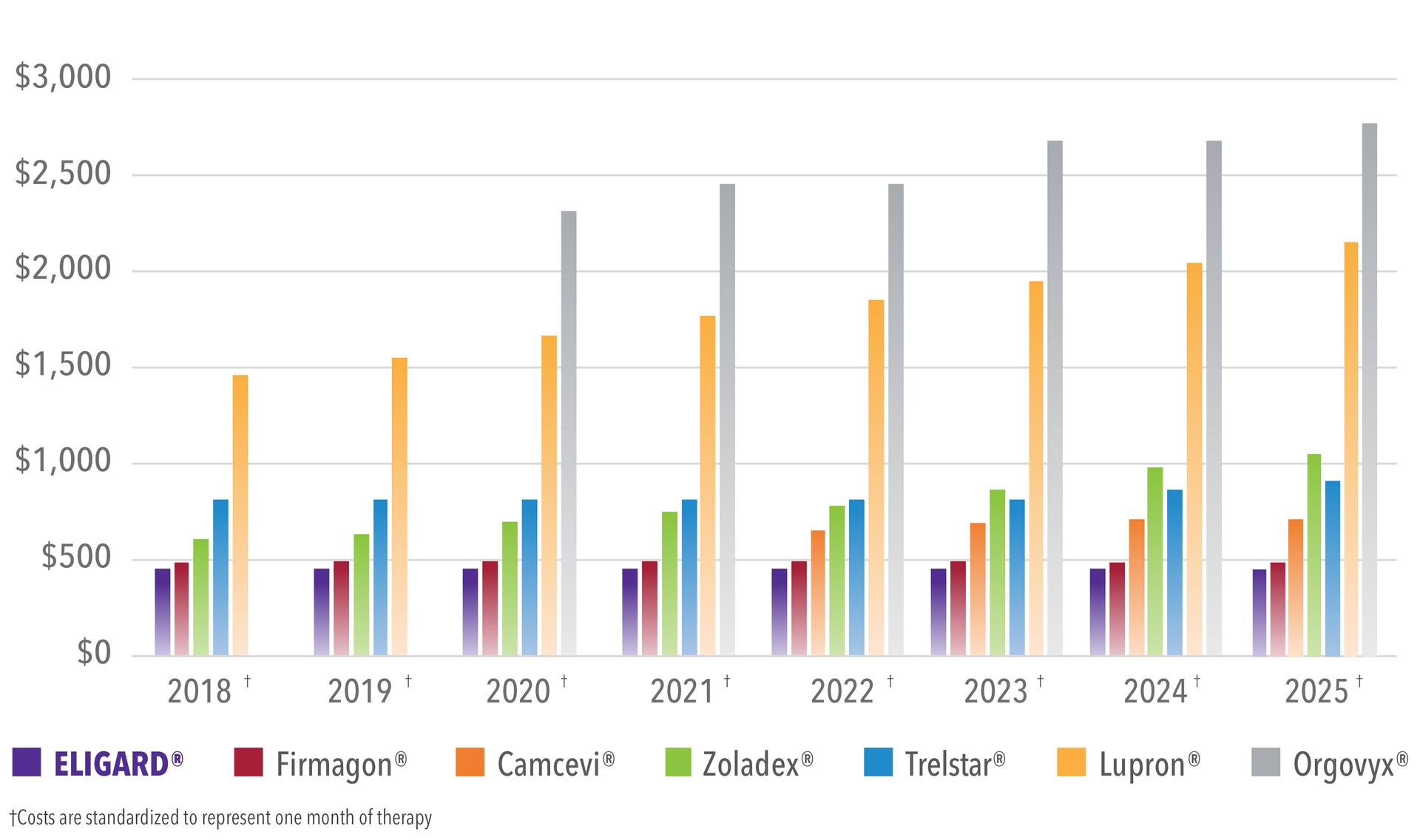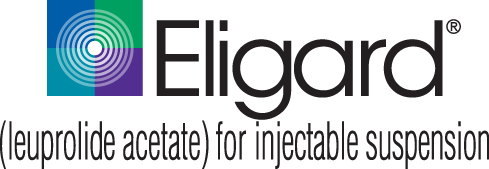© 2024 Tolmar, Inc. All rights reserved. Tolmar, ELIGARD and their associated logos are trademarks of the Tolmar Group. Third-party
trademarks and product names belong to their respective owners. TPI.2023.eng.4010.v3 06/25
Navigating rising costs for prostate cancer treatment
How drug costs can increase financial burden even with insurance coverage

Cost of cancer treatment
Cancer is one of the most expensive medical conditions to treat in the US and often leads to financial toxicity that can impact care.
- For patients with cancer, the mean total out-of-pocket cost burden as a share of annual income was 24%. One in five prostate cancer patients reported a need to reduce spending or make sacrifices to afford treatment.1,2
- Financial strain also is reported among insured patients in the United States. According to the results of a study conducted by the Kaiser Family Foundation analyzing data from 6,015 households, many families in the United States reported difficulties affording the annual deductible expenses associated with current health plans3
- The CDC reports that 50% percent of Medicare beneficiaries with cancer pay at least 10% of their income for cancer treatment and related out-of-pocket costs4

How drug prices can affect your out-of-pocket cost directly
A drug’s price can greatly affect the out-of-pocket cost therefore it is important to bring up and discuss financial toxicity with your doctor or nurse prior to starting treatment
If treatment cost is high, perhaps see if a similar, more responsibly priced product is available with similar efficacy and discuss with your physician if that alternative product is available and right for you.
Patient Cost Burden by Coverage Type*

Helping to cover co-pay or coinsurance cost
While there are many charitable organizations that can help with covering copay or coinsurance costs, many have strict income or geography requirements.
Funding can often be hard to find and very limited when available. It is important to ensure that your care team is utilizing that funding in the most efficient as possible

Using a product that is lower in price with similar efficacy can help ensure that those charitable funds stretch as far as possible.
Ways to help navigate financial toxicity:
Always discuss coverage and cost prior to starting a new therapy or drug
- “Do you know what my copay or coinsurance cost will be for this drug?”
- “What will be the annual cost for me to be on this drug”
- “Who is the best person at your office to talk to regarding financial burden for my treatment”
- “Can you refer me to the best patient advocacy groups who might offer assistance”
- My out-of-pocket cost has increased, do you know why? Was a different product used?
- Ensure you follow up since some products can have very similar benefits but costs can change drastically
ELIGARD has NOT had a price increase for over 10 years9
ELIGARD has consistently had one of the lowest prices in the LHRH market, ensuring that cost burden to the patient is kept as low as possible.


Tolmar meets the needs of patients and providers
Tolmar is committed to keeping ELIGARD responsibly priced to ensure access across healthcare systems, providers, and most importantly – patients
Patient Access Support
Practice Support
Clinical Support
Low OOP Expense
To learn more about ELIGARD’s proven efficacy and flexible dosing visit EligardHCP.com
IMPORTANT SAFETY INFORMATION
ELIGARD®, (leuprolide acetate) for injectable suspension, is a gonadotropin releasing hormone (GnRH) agonist indicated for the treatment of advanced prostate cancer.
ELIGARD is contraindicated in patients with hypersensitivity to GnRH, GnRH agonists, or any of the components of ELIGARD. Anaphylactic reactions to synthetic GnRH or GnRH agonists have been reported in the literature. Transient increase in serum levels of testosterone during treatment may result in worsening of symptoms or onset of new signs and symptoms during the first few weeks of treatment, including bone pain, neuropathy, hematuria, bladder outlet obstruction, ureteral obstruction, or spinal cord compression. Monitor patients at risk closely and manage as appropriate.
Hyperglycemia and an increased risk of developing diabetes have been reported in men receiving GnRH agonists. Monitor blood glucose level and manage according to current clinical practice. Increased risk of myocardial infarction, sudden cardiac death and stroke has also been reported with use of GnRH agonists in men. Monitor for cardiovascular disease and manage according to current clinical practice. Androgen deprivation therapy may prolong the QT/QTc interval. Consider risks and benefits. May cause fetal harm. Convulsions have been observed in patients taking leuprolide acetate with or without a history of predisposing factors. Manage convulsions according to current clinical practice.
ELIGARD may impair fertility in males of reproductive potential.
The most common injection site adverse events are transient burning and stinging, pain, bruising, and erythema. The most common systemic adverse events include mild to severe hot flashes/sweats, malaise and fatigue, weakness, myalgia, dizziness, clamminess, testicular atrophy, and gynecomastia. As with other GnRH agonists, other adverse reactions,
including decreased bone density and rare cases of pituitary apoplexy have been reported. Please visit EligardHCP.com for full Prescribing and Safety Information
References:
1. Conti RM, et al. Reform Medicare Part B to improve affordability and equity. Health Affairs, healthaffairs.org. Published Jun 25, 2021. Accessed May 7, 2025 https://www.healthaffairs.org/do/10.1377/forefront.20210622.349716/full/
2. Ginsburg PB, Lieberman SM. Medicare payment for physician-administered (Part B) drugs: the interim final rule and a better way forward. Brookings, brookings.edu. Published Feb 10, 2021. Accessed May 7, 2025 https://www.brookings.edu/blog/usc-brookings-schaeffer-on-health-policy/2021/02/10/medicare-payment-for-physician-administered-part-b-drugs
3. Claxton G, Rae M, Panchal N, et al. Health Benefits In 2015: Stable Trends In The Employer Market. Health Affairs. Vol. 34, N0. 10; Oct 2015
4. Pirschel C, Financial Toxicity and its Burden on Cancer Care https://voice.ons.org/news-and-views/financial-toxicity-and-its-burden-on-cancer-care
5. US Railroad Retirement Board. 2025 Medicare Part B Premiums and Deductibles Will Increase. RRB News. rrb.gov. Published Nov 2024. Accessed May 7, 2025 https://www.rrb.gov/sites/default/files/2024-11/NR2410.pdf
6. Centers for Medicare & Medicaid Services. Final CY 2025 Part D Redesign Program Instructions Fact Sheet. cms.gov. Published Apr 1, 2024. Accessed May 7, 2025 https://www.cms.gov/newsroom/fact-sheets/final-cy-2025-part-d-redesign-program-instructions-fact-sheet.
7. Kaiser Family Foundation. 2024 Employer Health Benefits Survey. kff.org. Published Oct 9, 2024. Accessed May 7, 2025 https://www.kff.org/report-section/ehbs-2024-summary-of-findings/
8. Kaiser Family Foundation. A Current Snapshot of the Medicare Part D Prescription Drug Benefit. kff.org. Published Oct 9, 2024. Accessed May 7, 2025 https://www.kff.org/medicare/issue-brief/a-current-snapshot-of-the-medicare-part-d-prescription-drug-benefit/
9. Data on file, Tolmar, Inc.; 2025


